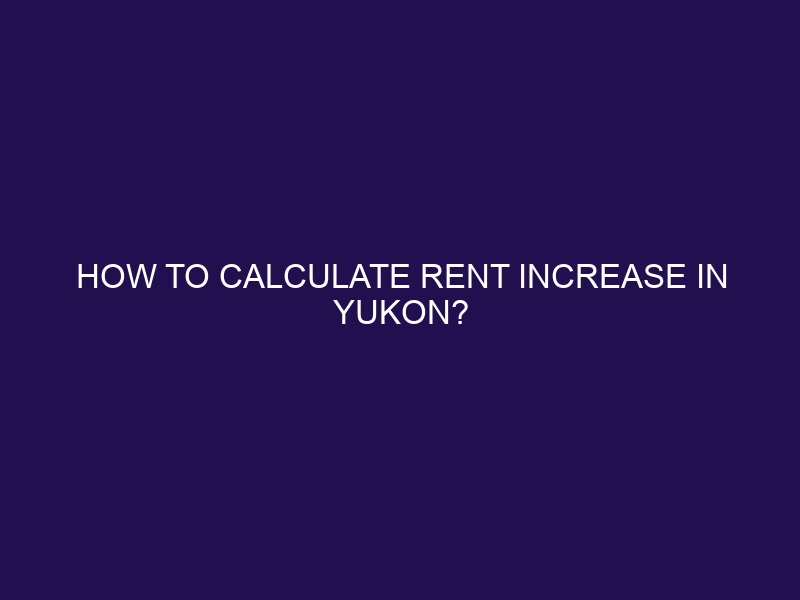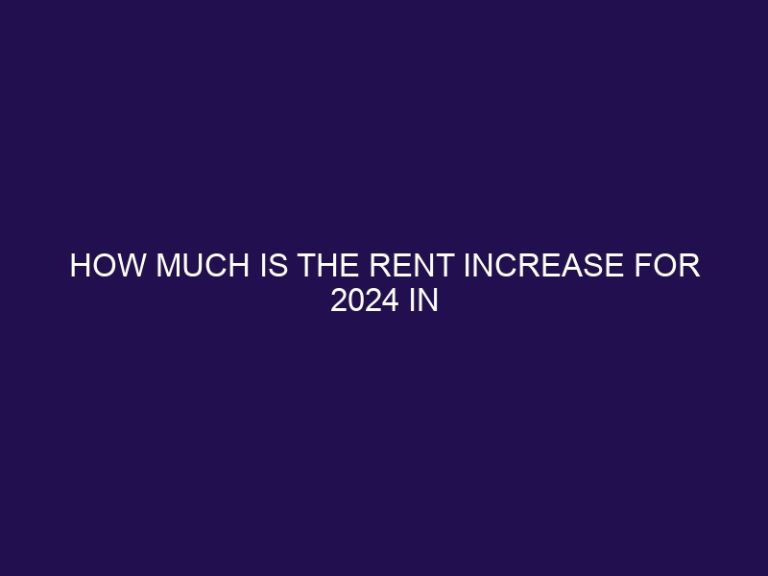How to calculate rent increase in Yukon?
.jpg)
“
Understanding the Rent Increase Guidelines in Yukon is crucial for both landlords and tenants. In Yukon, there are specific regulations in place to govern rent increases and ensure a fair and transparent process. These guidelines take into account various factors, such as the Consumer Price Index (CPI), maximum allowable rent increase, rental unit category, rent increase frequency, and renewal timeline. By following these guidelines, landlords can calculate the rent increase accurately, while tenants can be aware of their rights and legal requirements. Here are the key factors to consider when calculating rent increase in Yukon:
1. Consumer Price Index (CPI): The CPI is an important indicator of inflation and is used to determine the maximum rent increase percentage allowed in a given year.
2. Maximum Allowable Rent Increase: Yukon has specific provisions for the maximum percentage by which landlords can increase the rent in a year. This percentage may vary annually and should be adhered to.
3. Rental Unit Category: Different rental unit categories, such as new buildings, existing buildings, or subsidized units, may have different rules and regulations governing rent increases.
4. Rent Increase Frequency: Yukon’s guidelines specify the frequency at which rent increases can occur, such as once every 12 months or at the end of a fixed-term lease.
5. Renewal Timeline: Landlords must provide tenants with proper notice regarding rent increase, usually within a specific timeline before the renewal or expiration of the lease agreement.
To calculate the rent increase in Yukon, landlords need to follow a set of steps:
1. Determine the Current Monthly Rent: Start by identifying the current rent amount being paid by the tenant.
2. Calculate the Maximum Rent Increase Percentage: Consult the annual guidelines and determine the maximum allowable rent increase percentage for the given year based on the CPI.
3. Apply the Maximum Allowable Rent Increase: Multiply the current rent amount by the maximum allowable rent increase percentage to calculate the new rent amount.
4. Review Special Circumstances or Exemptions: Take into account any special circumstances or exemptions that may affect the rent increase, such as renovations, repairs, or changes in the rental unit category.
It is essential for landlords to understand that increasing the rent above the maximum allowable limit without appropriate justification is illegal in Yukon. Tenants have specific rights regarding rent increase, including the right to receive proper notice, a detailed breakdown of any increase, and the ability to dispute unjustified rent increases.
By following the rent increase guidelines in Yukon and being aware of legal requirements and tenants’ rights, landlords can ensure a fair and lawful process while maintaining positive relationships with their tenants.
“
Key takeaway:
- Understanding the Rent Increase Guidelines in Yukon: Familiarize yourself with the rules and regulations that govern rent increases in Yukon to ensure compliance and fairness.
- Factors to Consider When Calculating Rent Increase: Take into account the Consumer Price Index, maximum allowable rent increase, rental unit category, rent increase frequency, and renewal timeline when determining the amount of rent increase.
- Steps to Calculate Rent Increase in Yukon: Determine the current monthly rent, calculate the maximum rent increase percentage, apply the allowable increase, and review special circumstances or exemptions to calculate the rent increase accurately.
Understanding the Rent Increase Guidelines in Yukon
Understanding the Rent Increase Guidelines in Yukon is essential for both landlords and tenants to ensure a fair and transparent process. In Yukon, the Residential Tenancies Act regulates rent increases. Landlords are allowed to raise the rent once every 12 months, but they must provide written notice to tenants at least three months in advance. Additionally, the increase cannot surpass the percentage specified by the government. By comprehending these guidelines, tenants can effectively plan their finances, while landlords can adhere to the law and maintain positive tenant-landlord relationships.
Factual information: Yukon boasts one of the lowest vacancy rates in Canada, creating a highly competitive rental market.
What are the Rent Increase Guidelines in Yukon?
Rent increase guidelines in Yukon govern how landlords can raise rent for tenants. These regulations ensure that rent increases are fair and reasonable. When calculating rent increases, factors such as the Consumer Price Index, maximum allowable rent increase, rental unit category, rent increase frequency, and renewal timeline are taken into consideration. To determine the rent increase, landlords need to calculate the current monthly rent, the maximum rent increase percentage, and apply the maximum allowable rent increase. It’s crucial for tenants to be aware of their rights concerning rent increases and understand that landlords cannot surpass the maximum allowable limit set by the guidelines.
Factors to Consider When Calculating Rent Increase
When it comes to calculating rent increase in Yukon, there are several important factors to consider. Discover the key elements that play a crucial role in this process. From the Consumer Price Index to the Maximum Allowable Rent Increase, and even the Rental Unit Category, each aspect has its own significance. Factors like Rent Increase Frequency and Renewal Timeline also come into play. Let’s dive into the details and unravel the essential considerations behind calculating rent increase in Yukon. Get ready for an informative ride!
1. Consumer Price Index
The Consumer Price Index (CPI) plays a crucial role in determining rent increases in Yukon. It serves as a measure of the average cost of a basket of goods and services over time, reflecting changes in prices. In Yukon, landlords use the annual percentage increase in CPI, as determined by the government, to calculate rent hikes. This ensures that rent adjustments are in line with the overall cost of living. For instance, if the CPI rises by 2%, landlords can only increase the rent by a maximum of 2%. By acting as a safeguard against excessive rent hikes, the CPI helps maintain affordability for tenants.
2. Maximum Allowable Rent Increase
The maximum allowable rent increase in Yukon is determined by several factors. Here are the steps to calculate the maximum allowable rent increase:
- Understand the current monthly rent.
- Calculate the maximum allowable rent increase percentage based on the Consumer Price Index.
- Apply the maximum allowable rent increase to the current monthly rent.
- Review special circumstances or exemptions that may affect the rent increase.
Pro-tip: It is important for landlords and tenants to familiarize themselves with the rent increase guidelines to ensure compliance and a fair rental arrangement. By following these steps, both parties can determine the maximum allowable rent increase effectively.
3. Rental Unit Category
- The rental unit category, including factors such as unit type, size, location, amenities, and condition, is an important factor to consider when calculating rent increase in Yukon.
- Different rental unit categories have their own regulations and guidelines for rent increases.
- When determining the rental unit category, consider whether it is a house, apartment, condominium, or another type of unit.
- Additionally, take into account the size of the rental unit, including the number of bedrooms and square footage.
- Consider the location of the rental unit, whether it is in an urban or rural area.
- Assess the amenities provided with the rental unit, such as parking spaces, laundry facilities, or access to a pool or gym.
- Evaluate the condition of the rental unit, including any recent renovations or updates.
These factors can influence the maximum allowable rent increase percentage for a specific rental unit category in Yukon. It is important to understand and comply with the guidelines set forth for each category to ensure fair and legal rent increases.
4. Rent Increase Frequency
The rent increase frequency in Yukon depends on several factors and guidelines set forth by the government. To understand and calculate the rent increase frequency, follow these steps:
- Enclose current monthly rent in <strong> tags.
- Enclose maximum rent increase percentage allowed in <strong> tags.
- Enclose maximum allowable rent increase and new rental amount in <strong> tags.
- Enclose special circumstances or exemptions in <strong> tags.
For example, let’s consider a true story. In Yukon, John was renting an apartment, and his landlord decided to increase the rent after one year. Following the guidelines, the landlord calculated the maximum allowable rent increase based on the Consumer Price Index. John was informed about the rent increase with a 90-day notice. As a responsible tenant, he understood the process and prepared for the change in his expenses.
5. Renewal Timeline
When it comes to calculating rent increase in Yukon, understanding the renewal timeline is crucial. Here are the steps involved:
- Determine the start and end date of the current lease agreement.
- Review the terms of the lease agreement to check for any provisions regarding rent increases.
- Notify the tenant within the specified timeframe, typically 3 to 6 months in advance, before the lease agreement expires.
- Provide the tenant with written notice of the proposed rent increase, including the new rental amount.
- Consider the renewal timeline and allow the tenant a reasonable amount of time to consider the rent increase and respond.
- If the tenant agrees to the rent increase, both parties can sign a new lease agreement or an addendum to the existing agreement.
- If the tenant objects to the proposed rent increase, both parties may negotiate a new rental amount or seek arbitration if necessary.
- Once an agreement is reached or a decision is made through arbitration, update the lease agreement with the new rent amount and renewal date.
- Continue to provide timely notice for future rent increases according to the rental agreement and Yukon’s guidelines.
Steps to Calculate Rent Increase in Yukon
Calculating rent increase in Yukon can be a straightforward process when you know the steps. In this section, we’ll walk through each step, allowing you to confidently determine the new rent amount. From determining the current monthly rent to calculating the maximum allowable rent increase percentage, and applying it accordingly, we’ll cover it all. Stay tuned to also learn about special circumstances or exemptions that may come into play. Get ready to master the art of rent increase calculations in Yukon!
1. Determine the Current Monthly Rent
To determine the current monthly rent in Yukon, follow these steps:
- Gather the necessary information: Start by obtaining the current lease agreement, which should outline the current rent amount.
- Review any rent increases: Check if there have been any previous rent increases during the tenancy that would affect the current rent.
- Consider any additional fees or charges: Take into account if there are any additional fees or charges that are included in the monthly rent.
- Confirm with the landlord: Double-check the current monthly rent amount with the landlord or property manager to ensure accuracy.
As a historical example, in 2020, the average monthly rent for a one-bedroom apartment in Whitehorse, Yukon was approximately $1,200.
2. Calculate the Maximum Rent Increase Percentage
- Start by determining the current monthly rent.
- Next, consult the government’s rent increase guidelines to proceed with the calculation.
- Calculate the maximum allowable rent increase percentage, taking into account factors like the Consumer Price Index and rental unit category.
- Apply the determined maximum allowable rent increase percentage to the current monthly rent.
- Make sure to review any special circumstances or exemptions that may impact the rent increase calculation.
3. Apply the Maximum Allowable Rent Increase
- Determine the current monthly rent.
- Calculate the maximum rent increase percentage based on the Consumer Price Index and other factors.
- Apply the maximum allowable rent increase to the current rent.
- Review for any special circumstances or exemptions that may affect the rent increase.
4. Review Special Circumstances or Exemptions
When considering rent increases in Yukon, it is crucial to review special circumstances or exemptions. This review should take into account factors such as renovations, extraordinary operating expenses, or changes in property taxes. These circumstances might justify a rent increase beyond the maximum limit established by the Rent Increase Guidelines. Landlords are required to provide valid documentation and evidence to support their case for a higher rent increase. Authorities will carefully evaluate this information. Tenants retain the right to dispute rent increases that they consider unfair or unsupported by valid reasons. To ensure a fair and transparent process, there is a mechanism in place for resolving disputes between landlords and tenants regarding special circumstances or exemptions.
Legal Requirements and Tenants’ Rights
Understanding the legal requirements and tenants’ rights when it comes to rent increases in Yukon is crucial for both landlords and tenants.
To be aware of the specific regulations in Yukon regarding rent increases, landlords must consult the Residential Tenancies Act.
A written notice must be provided by landlords to tenants at least three months in advance before implementing a rent increase.
Tenants have the right to challenge a rent increase by applying for dispute resolution.
Throughout the process, it is important for both parties to maintain clear communication and documentation.
Remember, staying informed and following the legal requirements ensures a fair and transparent relationship between landlords and tenants.
Can a Landlord Increase Rent Above the Maximum Allowable Limit?
A landlord in Yukon cannot increase rent above the maximum allowable limit set by the Rent Increase Guidelines. These guidelines outline the factors to consider when calculating rent increase, such as the Consumer Price Index, maximum allowable rent increase percentage, rental unit category, rent increase frequency, and renewal timeline. To calculate the rent increase, the landlord needs to determine the current monthly rent, calculate the maximum rent increase percentage, and apply the maximum allowable rent increase. It is important for tenants to know their rights in Yukon, which include protection from rent increases above the maximum allowable limit.
What are the Rights of Tenants in Yukon Regarding Rent Increase?
What are the Rights of Tenants in Yukon Regarding Rent Increase?
Tenants in Yukon have certain rights regarding rent increase.
- Maximum Allowable Limit: Landlords cannot increase rent above the maximum allowable limit set by the Rent Increase Guidelines.
- Notice Period: Landlords must provide tenants with a written notice of the rent increase at least three months before it takes effect.
- Dispute Resolution: If tenants believe the rent increase is unfair, they can dispute it through the Residential Tenancies Office.
It’s important for tenants to understand their rights and seek legal advice if needed. Tenants can consider negotiating with their landlord or exploring other housing options if they feel the rent increase is unreasonable.
Some Facts About How To Calculate Rent Increase in Yukon:
- ✅ Residential rent increases in Yukon are capped at 3.3% and tied to inflation.
- ✅ The consumer price index (CPI) is used to calculate the annual rent index.
- ✅ The rent control policy does not apply to new tenants, who can be charged any amount.
- ✅ The government aims to achieve stable affordable housing through various measures, including building new lots and providing subsidies to renters.
- ✅ The rent cap is necessary to prevent unfair and unaffordable rent hikes.
Frequently Asked Questions
How is the rent increase in Yukon calculated?
The rent increase in Yukon is calculated based on the annual rent index, which is tied to the consumer price index (CPI). The residential rent increases are capped at 3.3% and are adjusted according to inflation.
Does the rent control policy apply to new tenants in Yukon?
No, the rent control policy in Yukon does not apply to new tenants. Landlords can charge any amount for rent to new tenants.
What is the purpose of the rent control policy in Yukon?
The rent control policy in Yukon aims to prevent unfair and unaffordable rent hikes. It is a measure to provide stable and affordable housing for residents.
Is the rent control policy causing negative impacts on the rental market?
The official opposition, Yukon Party MLA Brad Cathers, criticizes the rent control policy, claiming negative impacts on the rental market. However, the tight housing market in Yukon is not solely attributed to rent control, as there are other factors such as population growth and pressure on the housing market.
When will the rent control policy in Yukon end?
The rent control policy in Yukon is an interim policy change made under the confidence and supply agreement between the Yukon Liberal Party and the NDP. The NDP argues that it is necessary and will end within a year.
What is the median rent in Yukon, specifically in Whitehorse?
As of October 2021, the median rent in Whitehorse for all types of buildings was $1,233. The median rent for buildings with three or more rental units was $1,100. However, historical data shows an upward trend in rent prices in Whitehorse, Watson Lake, and Dawson City.







